
Odense is the third largest city in Denmark and the largest city on the island of Funen. As of 1 January 2023, the city proper had a population of 182,387 while Odense Municipality had a population of 207,762, making it the fourth largest municipality in Denmark. Eurostat and OECD have used a definition for the Metropolitan area of Odense, which includes all municipalities in the Province of Funen, with a total population of 504,066 as of 1 July 2022

Slagelse is a town on Zealand, Denmark. The town is the seat of Slagelse Municipality, and is the biggest town of the municipality. It is located 15 km east of Korsør, 16 km north-east of Skælskør, 33 km south-east of Kalundborg and 14 km west of Sorø.

Assistens Cemetery in Copenhagen, Denmark, is the burial site of many Danish notables as well as an important greenspace in the Nørrebro district. Inaugurated in 1760, it was originally a burial site for the poor laid out to relieve the crowded graveyards inside the walled city, but during the Golden Age in the first half of the 19th century it became fashionable and many leading figures of the epoch, such as Hans Christian Andersen, Søren Kierkegaard, Christoffer Wilhelm Eckersberg, and Christen Købke are all buried here.

Aarhus Cathedral is a cathedral in Aarhus, Denmark. It is the longest and tallest church in the country, at 93 m (305 ft) in length and 96 m (315 ft) in height.

The architecture of Denmark has its origins in the Viking period, richly revealed by archaeological finds. It became firmly established in the Middle Ages when first Romanesque, then Gothic churches and cathedrals sprang up throughout the country. It was during this period that, in a country with little access to stone, brick became the construction material of choice, not just for churches but also for fortifications and castles.

Herning is a Danish town in the Central Denmark Region of the Jutland peninsula. It is the main town and the administrative seat of Herning Municipality. Herning has a population of 51,193 including the suburbs of Tjørring, Snejbjerg, Lind, Birk, Hammerum, and Gjellerup, making Herning the 11th most populous urban area in Denmark.
Odense Håndbold is a Danish professional women's handball team, that plays in Damehåndboldligaen, Denmark's premier women's handball league. It was created in August 2009 and took over GOG Svendborg TGI's license for the league, which was published in a press meeting August 27, 2009 in Odense Idrætshal. They changed their name to Odense Håndbold before the beginning of the 2016/2017 season.
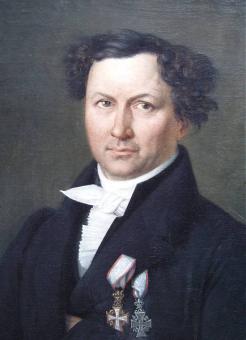
Jørgen Hansen Koch was a Neoclassical Danish architect. He was chief of the national Danish building administration from 1835 and director of the Royal Danish Academy of Fine Arts from 1844 to 1849.

CABINN Hotels is a Danish low-cost hotel chain with eight hotels in the five largest cities in Denmark: four in Copenhagen, one in Aarhus, one in Odense, one in Aalborg and one in Esbjerg. CABINN Hotels is owned by the entrepreneur Niels Fennet.

Hans Jørgen Hammer was a genre, landscape, and portrait painter and printmaker of the Golden Age of Danish painting. In addition, he served for eleven years as a military officer.
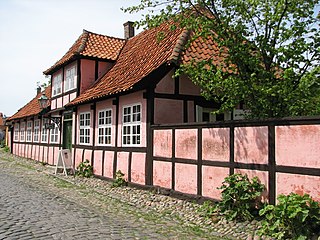
Erichsens Gård is a timber-framed building located at Rønne on Bornholm, Denmark. It is now part of the Bornholm Museum and is Rønne's best preserved commoner's house.
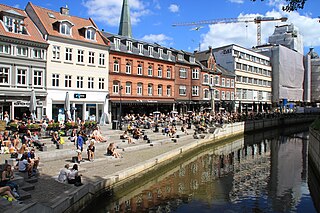
Indre By is a neighborhood in the city of Aarhus, Denmark. The neighborhood is bounded by Nørre Allé, Vester Allé and Sønder Allé and is composed of the neighborhood and historical centre of the Latin Quarter and the areas around the Central Station and the City Hall Park. The neighborhood is one of the three main neighborhoods in the district of Aarhus C, along with Frederiksbjerg and Vesterbro.

Business- and Agricultural Bank of Jutland is a listed building and a former Danish bank in Aarhus.

Moesgård is a former manor house and a listed building in Aarhus Municipality. The current buildings were completed in 1778 and was listed in the Danish registry of protected buildings and places by the Danish Heritage Agency on 17 July 1918.

The architecture of Aarhus comprises numerous architectural styles and works from the Middle Ages to present-day. Aarhus has a well-preserved medieval city center with the oldest dwellings dating back to the mid-1500s and some ecclesiastical structures such as St. Clemen's Cathedral and numerous smaller churches that can be traced back to the 1100s. The industrialization of the 19th and 20th centuries left distinctive industrial structures, important National romantic works and some of the best examples of Functionalist architecture in the country. The history of the city as a Viking fort is evidenced in the street layout of the Latin Quarter, the wider Indre By neighborhood testifies to its later role as a Market town and center of commerce while the Frederiksbjerg, Trøjborg and Marselisborg districts showcase the first cohesive urban planning efforts of the early 20th century.
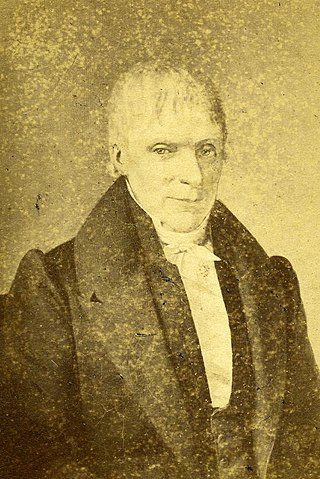
Harboe Galthen Meulengracht was a Danish merchant and shipowner in Denmark who was appointed to the Danish Supreme Court and was purveyor to the royal household.

Store Torv is a public square located in the Indre By neighborhood in Aarhus, Denmark. It is situated between Lille Torv and Aarhus Cathedral, shaped as an elongated triangle. It is the largest public square in Aarhus and one of the oldest venues for markets in the city. The square is home to many notable buildings including the dominating cathedral and is frequently host to cultural events.
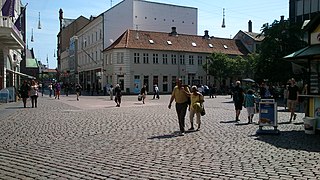
Lille Torv is a cobbled public square located in the Indre By neighborhood in Aarhus, Denmark. It is situated between the squares of Store Torv and Immervad in the historic Latin Quarter neighborhood and it is one of the oldest public squares in Aarhus. The streets of Vestergade, Guldsmedgade, Immervad and Badstuegade radiates from Lille Torv. It is today a venue for public events and gatherings in the city. The square is home to some notable buildings such as the storied Meulengracht's House and the listed Business- and Agricultural Bank of Jutland.
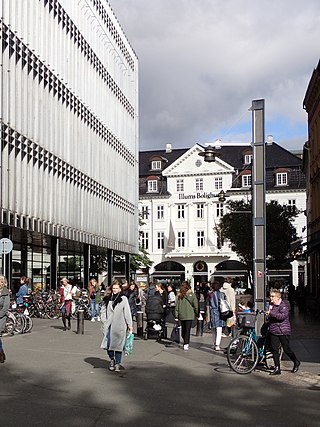
Immervad, previously Emmervad, is a pedestrian street in Aarhus, Denmark, which runs north to south from Lille Torv to Åboulevarden and Frederiksgade. The alley Sankt Clemens Stræde leads to Immervad from the east. The street is situated in the historic Latin Quarter neighborhood and has existed as a road or street since the Viking Age when it was used as the eastern ford to cross the Aarhus River. Immervad is fairly short at just 110 meters long but it is one of the streets with the most foot traffic in Aarhus. At the southern section of the street is the bridge of Frederiksbroen, the first bridge built to cross the river in the city.

Gråbrødretorv 6 is a building at the corner of Gråbrødretorv and Niels Hemmingsens Gade in the Old Town of Copenhagen, Denmark. The oldest parts of the building date from the 1730s but it owes its current appearance to a reconstruction in 1818 and an adaptation undertaken by Valdemar Ingemann in 1881. It was listed in the Danish registry of protected buildings and places in 1945. Former residents include bishop Hans Lassen Martensen and businessman Jacob Heinrich Moresco.




















